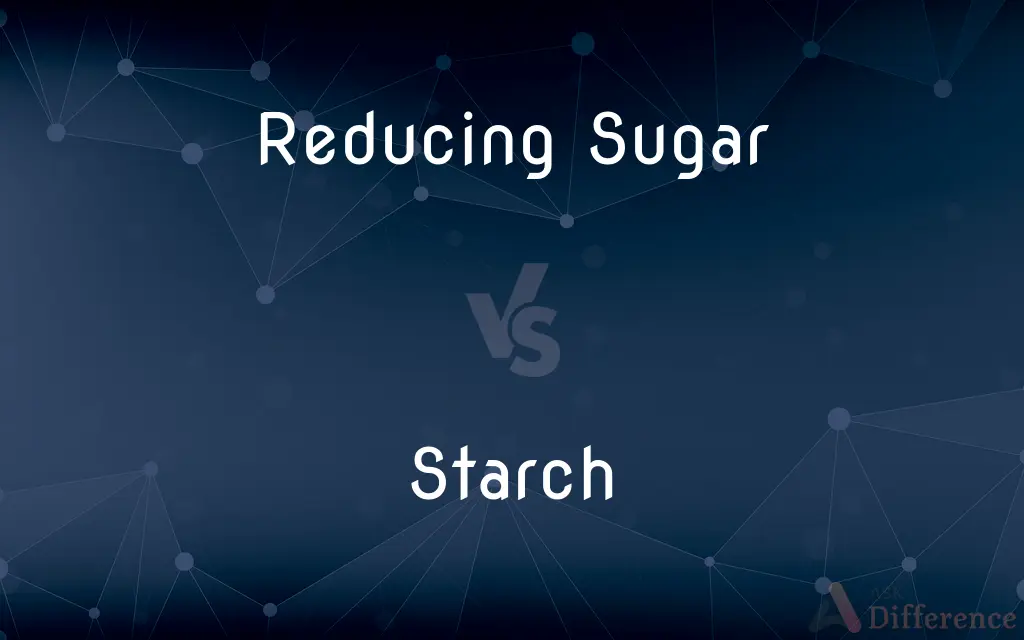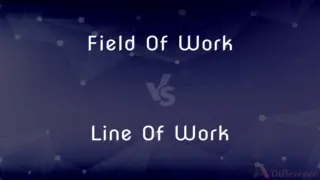Reducing Sugar vs. Starch — What's the Difference?
Edited by Tayyaba Rehman — By Fiza Rafique — Published on November 17, 2023
Reducing Sugar can donate electrons in chemical reactions; Starch is a complex carbohydrate stored in plants. Both provide energy but differ chemically.

Difference Between Reducing Sugar and Starch
Table of Contents
ADVERTISEMENT
Key Differences
Reducing Sugar refers to any sugar that can act as a reducing agent due to its free aldehyde or ketone group. On the other hand, Starch is a polysaccharide that plants use to store energy, primarily found in grains and tubers. Both Reducing Sugar and Starch play significant roles in our diet, though they are chemically distinct.
Reducing Sugars, such as glucose and fructose, can easily react with other compounds because of their free reactive groups. Starch, however, is a long chain of glucose molecules linked together, making it less reactive compared to reducing sugars. It's noteworthy how Reducing Sugar and Starch differ in their reactivity and structural intricacies.
When consumed, Reducing Sugars provide instant energy as they are easily absorbed into the bloodstream. Starch, conversely, needs to be broken down into simpler sugars by enzymes before our body can use it for energy. The metabolic pathways of both Reducing Sugar and Starch underscore their different nutritional impacts.
In laboratory tests, Reducing Sugars can be detected using Benedict's solution, which turns from blue to orange or red in their presence. Starch, in contrast, can be identified using iodine solution, which turns from brown to dark blue or purple when it reacts with starch. These distinctive tests between Reducing Sugar and Starch highlight their unique chemical properties.
Comparison Chart
Chemical Structure
Contains free aldehyde or ketone groups
Long chain of glucose molecules
ADVERTISEMENT
Reactivity
High due to free reactive groups
Low compared to reducing sugars
Primary Function
Provides instant energy
Acts as energy storage in plants
Digestion
Quickly absorbed into the bloodstream
Needs enzymatic breakdown to simpler sugars
Detection in Lab
Turns Benedict's solution orange or red
Turns iodine solution dark blue or purple
Compare with Definitions
Reducing Sugar
Can donate electrons in reactions.
The reducing property of Reducing Sugar is used in many laboratory tests.
Starch
Provides prolonged energy release when consumed.
Foods high in Starch can help sustain energy levels over time.
Reducing Sugar
A sugar containing free aldehyde or ketone groups.
Glucose is a common type of Reducing Sugar.
Starch
Composed of long chains of glucose molecules.
Starch is broken down into glucose during digestion.
Reducing Sugar
Found in many natural foods.
Fruits are rich sources of Reducing Sugar.
Starch
A polysaccharide used by plants to store energy.
Potatoes are a good source of Starch.
Reducing Sugar
Reacts with Benedict's solution.
The presence of Reducing Sugar can change the color of Benedict's solution.
Starch
A naturally abundant nutrient carbohydrate, (C6H10O5)n, found chiefly in the seeds, fruits, tubers, roots, and stem pith of plants, notably in corn, potatoes, wheat, and rice, and varying widely in appearance according to source but commonly prepared as a white amorphous tasteless powder.
Reducing Sugar
Provides quick energy when consumed.
Consuming Reducing Sugar can lead to rapid spikes in blood sugar levels.
Starch
Any of various substances, such as natural starch, used to stiffen cloth, as in laundering.
Starch
Starches Foods having a high content of starch, as rice, breads, and potatoes.
Starch
Stiff behavior
"Dobbs, the butler ... isn't as stiff as he used to be.
Ann, my brother's new wife, has loosened up his starch a bit" (Jennifer St. Giles).
Starch
Vigor; mettle
"Business travel can take the starch out of the most self-assured corporate titan" (Lisa Faye Kaplan).
Starch
To stiffen with starch.
Starch
(uncountable) A widely diffused vegetable substance, found especially in seeds, bulbs and tubers, as extracted (e.g. from potatoes, corn, rice, etc.) in the form of a white, glistening, granular or powdery substance, without taste or smell, and giving a very peculiar creaking sound when rubbed between the fingers. It is used as a food, in the production of commercial grape sugar, for stiffening linen in laundries, in making paste, etc.
Starch
Carbohydrates, as with grain and potato based foods.
Starch
(uncountable) A stiff, formal manner; formality.
Starch
(uncountable) Fortitude.
Starch
(countable) Any of various starch-like substances used as a laundry stiffener
Starch
To apply or treat with laundry starch, to create a hard, smooth surface.
She starched her blouses.
Starch
Stiff; precise; rigid.
Starch
Stiff; precise; rigid.
Starch
A widely diffused vegetable substance found especially in seeds, bulbs, and tubers, and extracted (as from potatoes, corn, rice, etc.) as a white, glistening, granular or powdery substance, without taste or smell, and giving a very peculiar creaking sound when rubbed between the fingers. It is used as a food, in the production of commercial grape sugar, for stiffening linen in laundries, in making paste, etc.
Starch
Fig.: A stiff, formal manner; formality.
Starch
To stiffen with starch.
Starch
A complex carbohydrate found chiefly in seeds, fruits, tubers, roots and stem pith of plants, notably in corn, potatoes, wheat, and rice; an important foodstuff and used otherwise especially in adhesives and as fillers and stiffeners for paper and textiles
Starch
Stiffen with starch;
Starch clothes
Starch
Detected using iodine solution in labs.
A dark blue color indicates the presence of Starch when tested with iodine.
Starch
Found abundantly in grains and tubers.
Rice and corn are staple sources of Starch in many diets.
Common Curiosities
Can Reducing Sugar be found in fruits?
Yes, many fruits contain Reducing Sugars, such as glucose and fructose.
Are all sugars Reducing Sugars?
No, not all sugars are Reducing Sugars. For example, sucrose isn't a Reducing Sugar.
What is the primary function of Starch in plants?
Starch serves as the main energy storage molecule in plants.
What makes a sugar a "Reducing Sugar"?
A Reducing Sugar contains free aldehyde or ketone groups, allowing it to act as a reducing agent.
How can I test for the presence of Reducing Sugar in a solution?
You can use Benedict's solution, which changes color in the presence of Reducing Sugar.
Which foods are high in Starch?
Foods like potatoes, rice, and corn are rich in Starch.
Can Starch be found in animal products?
Starch is primarily a plant product. Animal products typically don't contain Starch.
Why do athletes consume foods high in Starch?
Foods high in Starch provide prolonged energy release, beneficial for sustained physical activity.
How does the body utilize Starch?
The body breaks down Starch into simpler sugars using enzymes, which are then used for energy.
What color does iodine turn when it reacts with Starch?
Iodine solution turns dark blue or purple when it reacts with Starch.
Are Reducing Sugars essential for the body?
While Reducing Sugars provide quick energy, excessive intake can be harmful. Balance is key.
How does the body respond to high intake of Reducing Sugar?
High intake can lead to rapid spikes in blood sugar levels, which may be harmful over time.
Share Your Discovery

Previous Comparison
Field Of Work vs. Line Of Work
Next Comparison
Public Administration vs. Private AdministrationAuthor Spotlight
Written by
Fiza RafiqueFiza Rafique is a skilled content writer at AskDifference.com, where she meticulously refines and enhances written pieces. Drawing from her vast editorial expertise, Fiza ensures clarity, accuracy, and precision in every article. Passionate about language, she continually seeks to elevate the quality of content for readers worldwide.
Edited by
Tayyaba RehmanTayyaba Rehman is a distinguished writer, currently serving as a primary contributor to askdifference.com. As a researcher in semantics and etymology, Tayyaba's passion for the complexity of languages and their distinctions has found a perfect home on the platform. Tayyaba delves into the intricacies of language, distinguishing between commonly confused words and phrases, thereby providing clarity for readers worldwide.











































